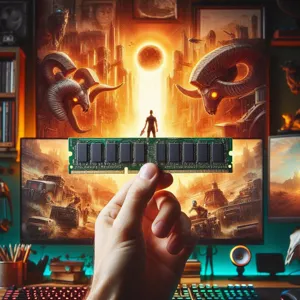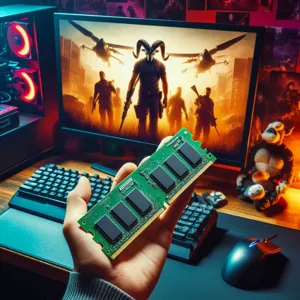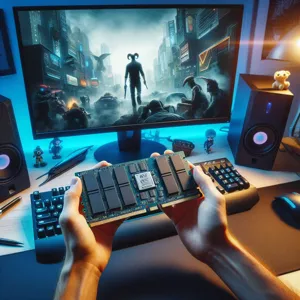In the dynamic world of PC gaming, where graphics and processing power continue to evolve at a staggering pace, the question of how much RAM you truly need has become increasingly relevant.
As games become more complex, featuring expansive open worlds, intricate graphics, and demanding multitasking requirements, the importance of adequate memory cannot be overstated. Whether you’re a casual gamer enjoying the latest indie title or a hardcore enthusiast diving into AAA blockbusters, understanding your RAM needs is crucial for optimizing performance and enhancing your overall gaming experience. In this blog post, we’ll explore the intricacies of RAM, debunk common myths, and provide practical insights to help you determine the ideal amount of memory for your gaming rig. Get ready to unlock the full potential of your setup and elevate your gameplay to new heights!
1. Understanding RAM: What It Is and How It Works

When it comes to gaming, RAM (Random access Memory) is a critical component that often gets overshadowed by flashy graphics cards and powerful processors. But what exactly is RAM, and how does it influence your gaming experience? Understanding its role is essential for optimizing your PC’s performance.
At its core, RAM is a type of volatile memory that your computer uses to store data that is actively being used or processed. Unlike your hard drive or SSD, which retain information even when the power is off, RAM loses its contents as soon as you shut down your computer. This makes it incredibly fast, allowing your CPU to access and manipulate data quickly without the delays associated with slower storage devices.
When you launch a game, your system loads critical files—like textures, game assets, and code—into RAM for immediate access. The more RAM you have, the more data your system can juggle simultaneously, which is particularly beneficial for open-world games or titles that require heavy multitasking. Imagine trying to run a massive open-world RPG while simultaneously streaming music and chatting with friends; insufficient RAM can lead to lag, stuttering, and long loading times, ruining your immersive experience.
Furthermore, modern games are designed to take advantage of higher amounts of RAM, especially those with intricate graphics and vast game worlds. As requirements increase, having adequate RAM not only helps in improving frame rates but also reduces the likelihood of crashes and performance hitches. So, when optimizing your gaming rig, understanding how RAM works and its impact on your overall experience is the first step in unlocking the full potential of your PC gaming setup.
2. The Role of RAM in Gaming Performance
When it comes to gaming performance, RAM plays a crucial role that often goes overlooked in discussions about hardware upgrades. Think of RAM, or Random Access Memory, as your computer’s short-term memory – it temporarily stores data that your CPU needs to access quickly. In the context of gaming, this means that RAM holds game assets like textures, models, and scripts, allowing for smoother gameplay and quicker load times.
Having sufficient RAM ensures that your system can handle the demands of modern games, which often require more memory than their predecessors. Today’s AAA titles are designed with expansive worlds and intricate details, meaning they can consume a significant amount of RAM during gameplay. If your system is under-equipped, you may experience lag, stuttering, or longer loading screens, detracting from the immersive experience that gaming is meant to provide.
Moreover, RAM not only affects performance during gaming but also during multitasking. If you enjoy streaming your gameplay while chatting with friends or browsing the web, having ample RAM allows your system to juggle these tasks without a hitch. A system with insufficient RAM might struggle to keep up, leading to frustrating interruptions and a subpar gaming experience.
In essence, the role of RAM in gaming performance is foundational. It supports the seamless rendering of graphics, enhances loading times, and enables efficient multitasking. Understanding this can help you make informed decisions about your PC’s specifications, ensuring that you’re not just meeting the minimum requirements for your favorite games but are set up for an optimal gaming experience that keeps you engaged and in the action.
3. Minimum vs. Recommended RAM Requirements for Popular Games

When it comes to PC gaming, understanding the difference between minimum and recommended RAM requirements can be a game-changer—literally. Many popular titles come with specified RAM thresholds that players should meet to ensure a smooth gaming experience.
Minimum RAM requirements represent the bare minimum amount of memory your system needs to run a game. Think of this as the ‘entry-level’ standard; it allows the game to launch and run, but often at a subpar performance level. You might experience stuttering, long loading times, and a lack of graphical fidelity. For example, a game like *Call of Duty: Warzone* lists a minimum requirement of 12GB of RAM. While you’ll be able to play, the experience may not be enjoyable, especially in high-action scenarios where every millisecond counts.
On the other hand, recommended RAM requirements indicate the optimal amount of memory for a seamless gaming experience. This is what developers suggest for enjoying the game with high settings, improved frame rates, and fewer performance hiccups. For the same *Call of Duty: Warzone*, the recommended requirement jumps to 16GB of RAM. Meeting or exceeding this can significantly enhance your gameplay, allowing for better multitasking, smoother graphics, and an overall richer experience.
As games evolve, so do their requirements. Titles are becoming increasingly demanding, and while you may meet the minimum specs today, you might find your setup lagging behind as new patches and expansions are released. Therefore, investing in a RAM upgrade—not only for now but for future-proofing your gaming rig—can be crucial.
Ultimately, understanding these requirements will empower you to make informed decisions about your gaming setup. Whether you’re a casual player or a competitive gamer, knowing the RAM landscape can unlock the full potential of your gaming experience.
4. How Much RAM Do Modern Games Use?
When it comes to modern gaming, the amount of RAM your system has can significantly impact performance and overall gaming experience. Today’s games are more immersive and demanding than ever, often featuring expansive worlds, intricate mechanics, and realistic graphics that require substantial memory resources.
Most current titles recommend a minimum of 8GB of RAM for smooth gameplay, especially for casual gamers. However, if you want to dive into more demanding games, especially those with high-definition graphics or multiplayer modes, upgrading to 16GB is highly advisable. This amount allows for greater multitasking and ensures that you can run background applications—like game launchers, streaming software, or voice chat programs—without hindering your gaming performance.
For hardcore gamers or those who want to future-proof their systems against upcoming releases, 32GB of RAM is becoming increasingly common. Many AAA titles now utilize this amount to deliver enhanced performance, allowing for smoother frame rates and quicker load times. Moreover, with the emergence of technologies such as ray tracing and virtual reality, having ample RAM ensures that your system can handle the extra demands of these cutting-edge features.
Ultimately, the amount of RAM you need hinges on the type of games you play and your overall gaming setup. While 8GB might suffice for casual play, investing in 16GB or more can provide a noticeable boost in performance, allowing you to enjoy the full spectrum of what modern gaming has to offer without compromise.
5. The Impact of RAM on Loading Times and Frame Rates

When it comes to PC gaming, the importance of RAM cannot be overstated. It serves as the bridge between your CPU and the data it needs to access quickly, directly influencing both loading times and frame rates—two critical factors that can make or break your gaming experience.
Imagine diving into a sprawling open-world game, anticipation building as you prepare to explore lush landscapes and engage in epic battles. Suddenly, you’re met with frustratingly long loading screens. This is where your RAM steps into the spotlight. Adequate RAM ensures that your system can store and manage the vast amounts of data required for these expansive environments. A gaming rig with insufficient RAM will struggle to keep up, resulting in delays as the system swaps data in and out of memory, leaving you staring at a loading screen while your excitement dwindles.
But it doesn’t stop there. The impact of RAM extends far beyond loading times. Frame rates—the number of frames your graphics card can render per second—are heavily influenced by how quickly your system can process and deliver data to the gpu. Higher frame rates not only create a smoother, more visually appealing experience but can also give you a competitive edge in fast-paced games. If your system is running low on RAM, you might experience stuttering or dips in performance during intense gaming moments, making it challenging to maintain that critical focus and reaction time.
In summary, sufficient RAM is essential for a seamless gaming experience. It reduces loading times, enhances frame rates, and ultimately allows you to immerse yourself fully in the game world. Whether you’re a casual gamer or a competitive player, understanding the impact of RAM will help you make informed decisions when it comes to upgrading your system for optimal performance.
6. Dual Channel vs. Single Channel RAM: Which Is Better for Gaming?
When it comes to optimizing your gaming experience, the type of RAM configuration you choose can significantly impact your system’s performance. The ongoing debate between dual channel and single channel RAM often leaves gamers wondering which option is the most beneficial for their setup.
In a nutshell, dual channel RAM can enhance performance by increasing the bandwidth available for data transfer, allowing your CPU to access memory more efficiently. This configuration utilizes two RAM sticks instead of one, effectively doubling the data paths between the memory and the processor. For gaming, where quick data access is crucial, this can lead to smoother gameplay and reduced frame times. Many modern titles demand quick, responsive performance, and dual channel RAM can give you that edge, particularly in high-action scenarios where every millisecond counts.
On the other hand, while single channel RAM can still get the job done, it may not maximize your system’s potential. With only one data path, the bandwidth is limited, which can lead to bottlenecks, especially in memory-intensive games. If you’re running a budget build or upgrading an existing system, single channel RAM might seem like a more economical choice, but it’s essential to weigh that against the possible performance trade-offs.
For gamers aiming for the best experience, investing in dual channel RAM is generally the recommended route. It not only enhances overall system performance but also future-proofs your setup for the latest gaming titles that demand higher memory speeds and bandwidth. In conclusion, while both configurations have their place, dual channel RAM stands out as the superior option for serious gamers looking to unlock the full potential of their PCs.
7. The Importance of RAM Speed and Latency

When it comes to PC gaming, the importance of RAM speed and latency cannot be overstated. While many gamers focus primarily on the amount of RAM, the performance of your memory modules plays a crucial role in overall system responsiveness and in-game performance. Think of RAM speed as the speed limit on a highway: it determines how fast data can travel to and from your CPU. Higher clock speeds (measured in megahertz, or MHz) can lead to better frame rates and smoother gameplay, especially in demanding titles that require quick access to data.
However, speed alone isn’t the whole picture. Latency, measured in CL (CAS Latency), refers to the delay between a request for data and the delivery of that data. Lower latency values indicate faster response times, meaning your system can access information more quickly. When evaluating RAM, both speed and latency should be considered in tandem. For instance, a RAM module with a higher speed but significantly higher latency might not perform as well as a slightly slower module with lower latency.
For gamers, this means that investing in RAM with both high speed and low latency can provide a noticeable boost in performance, particularly in CPU-intensive games or when multitasking with streaming and gaming simultaneously. In competitive gaming scenarios, where every millisecond counts, having RAM that can swiftly handle data transfers can mean the difference between victory and defeat. Ultimately, understanding the balance between RAM speed and latency can help you unlock the full potential of your gaming rig, ensuring that your system runs at peak performance for all your gaming adventures.
8. How to Determine Your Current RAM Usage While Gaming
To make informed decisions about upgrading your RAM, it’s crucial to understand your current usage while gaming. Knowing how much RAM your system consumes during gameplay can help you identify whether your hardware is bottlenecking your gaming experience. Fortunately, assessing your RAM usage is a straightforward process, and you can do it with just a few clicks.
start by launching the game you want to analyze. Once you’re in the game, press **Ctrl + Shift + Esc** to open the Task Manager on Windows. This brings up a detailed view of your system’s performance. Navigate to the **Performance** tab, where you can find a wealth of information about your CPU, memory, disk, and GPU usage. Click on the **Memory** section to see real-time data on your RAM usage.
Alternatively, for a more in-depth look, consider using tools like **MSI Afterburner** or **HWMonitor**. These programs provide detailed metrics, including how much RAM each application is utilizing while you’re gaming. They allow you to overlay performance stats directly onto your game screen, giving you an instant view of your RAM consumption during intense gaming sessions.
As you monitor your RAM usage, pay close attention to periods of high activity—especially in graphically demanding scenes or during multiplayer matches. If your RAM usage consistently hovers near or exceeds 80%, you may be experiencing slowdowns, stuttering, or longer load times—clear indicators that your current RAM might not be sufficient for an optimal gaming experience.
Additionally, don’t forget to check other background applications that might be consuming resources. Close unnecessary programs before gaming to ensure your system is dedicating as much RAM as possible to your game. By regularly assessing your RAM usage, you can make educated choices about whether it’s time to upgrade your memory for smoother gameplay and enhanced performance.
9. Upgrading RAM: When and Why You Should Consider It
Upgrading RAM can be one of the most impactful changes you make to enhance your gaming experience, but knowing when and why to consider this upgrade is essential for maximizing your investment. If you find yourself frequently experiencing lag or stutter during gameplay, or if your system struggles to maintain smooth frame rates in more demanding titles, it’s a sign that your current RAM may be holding you back.
One of the most telling indicators that it’s time to upgrade is the performance of your games when they are running alongside other applications. If multitasking becomes a hassle, and you notice significant slowdowns while streaming, chatting, or even just browsing the web, your RAM might be maxed out. Modern games often require more memory than ever, especially with the trend toward expansive open worlds and complex in-game mechanics. If your setup is operating with less than 16GB of RAM, you may be doing yourself a disservice.
Upgrading RAM can also future-proof your gaming rig. As game developers continue to push the boundaries of graphics and gameplay, the demand for memory is only set to rise. Investing in additional RAM now could save you from needing a more significant overhaul later. Furthermore, if you plan on diving into resource-intensive activities like video editing or 3D rendering, having ample RAM will provide a smoother workflow and help your overall performance.
Before making the leap to upgrade, it’s wise to check your current RAM usage through your system settings or a monitoring tool. If you’re consistently using 80% or more of your RAM while gaming, it’s time to consider an upgrade. Additionally, ensure compatibility with your motherboard and existing RAM specifications to avoid potential issues.
In summary, if you’re seeking a more fluid gaming experience, less frustration with system slowdowns, and a setup that can handle the games of tomorrow, upgrading your RAM is a smart move that can unlock your PC’s full potential.
10. Balancing RAM with Other Components for Optimal Performance
When it comes to PC gaming, achieving optimal performance isn’t solely about outfitting your machine with the highest possible amount of RAM. It’s crucial to consider how RAM interacts with other components in your build, creating a harmonious balance that maximizes your gaming experience.
First and foremost, the central processing unit (CPU) plays a significant role in determining how much RAM you actually need. A powerful CPU can handle more data simultaneously, meaning it will benefit from higher RAM capacity. However, if your CPU is low-end, it may not utilize all that RAM effectively, leading to wasted resources and underwhelming performance. Aim for a balanced pairing: a competent CPU complemented by an adequate amount of RAM, typically between 16GB and 32GB, depending on your gaming needs.
Next, let’s not overlook the graphics processing unit (GPU). This vital component is responsible for rendering graphics and can be a significant bottleneck if it doesn’t match or exceed the performance of your RAM and CPU. For example, if you have an extremely powerful GPU but are only using 8GB of RAM, you might find that you’re not fully utilizing the potential of your graphics card in modern, resource-intensive games. Conversely, a high amount of RAM paired with a mediocre GPU will not lead to a markedly improved gaming experience. Strive for a configuration where your RAM, CPU, and GPU are balanced to avoid any single component holding back the others.
Lastly, consider storage options. Solid State Drives (SSDs) are a game-changer, significantly improving load times and the overall responsiveness of your system. While RAM holds and manages data temporarily, an SSD provides the speed to access and store data quickly, which can complement your RAM capacity. When you have enough RAM to handle your games and an SSD to load them swiftly, you’ll notice a smoother and more enjoyable gaming experience.
In summary, balancing RAM with other components such as the CPU, GPU, and storage is essential for unlocking the full potential of your gaming rig. Instead of fixating solely on RAM, take a holistic approach to your system’s build—ensuring that each part works in concert with the others. This strategy not only enhances performance but also future-proofs your gaming setup for the ever-evolving demands of new titles.
11. Tips for Choosing the Right RAM for Your Gaming PC
When it comes to building or upgrading your gaming PC, selecting the right RAM is pivotal to unlocking optimal performance. Here are some essential tips to guide you in making the best choice for your gaming rig:
1. **Understand Your Needs**: Start by assessing the types of games you play and the multitasking you intend to do. If you’re a casual gamer who enjoys indie titles or older games, 8GB of RAM might suffice. However, for modern AAA games and resource-intensive applications, aim for at least 16GB to ensure smooth gameplay and efficient performance.
2. **Consider Speed and Latency**: RAM speed, measured in megahertz (MHz), can significantly impact your gaming experience. Look for RAM with higher speeds, typically between 3000MHz and 3600MHz, which can provide a noticeable boost in frame rates. Additionally, pay attention to the CAS latency (CL); lower latency generally means faster access times. Balancing speed and latency will enhance your system’s responsiveness.
3. **Check Compatibility**: Before purchasing RAM, ensure that it is compatible with your motherboard and CPU. Check the motherboard specifications for supported RAM types (DDR4, DDR5) and maximum capacity. Using RAM that is incompatible can lead to performance bottlenecks or system instability.
4. **Choose the Right Configuration**: Depending on your motherboard, decide whether to opt for a single stick or a dual-channel configuration. Dual-channel setups, which utilize two RAM sticks working in tandem, can provide better performance by doubling the data transfer rate. If you have the budget, consider a 2x8GB configuration for a total of 16GB.
5. **Future-Proofing Your Build**: Investing in more RAM than you currently need can be a wise decision for future-proofing. As games become more demanding and software evolves, having additional RAM available can ensure your system remains capable for years to come. Aim for at least 16GB now, with the option to expand later if necessary.
6. **Look for Aesthetics**: While performance is paramount, the appearance of your RAM can also be important, especially for gamers who take pride in their build. Consider RAM with customizable RGB lighting or sleek heat spreaders that complement your overall aesthetic.
By keeping these tips in mind, you can confidently choose the right RAM for your gaming PC, ensuring you achieve the performance necessary for an immersive and enjoyable gaming experience. With the right memory in place, you’ll be ready to tackle any challenge that comes your way in the virtual world.
12. Future-Proofing Your Gaming Setup: Is More RAM Necessary?
When it comes to gaming, the question of how much RAM is necessary often leads to the tantalizing concept of future-proofing your setup. As technology rapidly advances, game developers are constantly pushing the boundaries of graphics, world-building, and artificial intelligence, which in turn demands more from your hardware. In this context, the notion of “more RAM” becomes increasingly relevant.
Today, many modern games recommend a minimum of 16GB of RAM for optimal performance, especially at higher settings. However, looking ahead, it’s wise to consider the trajectory of gaming requirements. Titles that are being released in the next few years may require even more memory to handle expansive open worlds, complex simulations, and high-resolution textures. So, is it time to invest in 32GB or even 64GB of RAM?
While 16GB will suffice for most current games, opting for additional RAM could offer a significant advantage in both performance and longevity. Imagine diving into an immersive RPG with hundreds of NPCs, or engaging in fast-paced multiplayer battles where every millisecond counts. With extra RAM, your system can manage background processes more efficiently, reducing the likelihood of lag and stuttering that can detract from your gaming experience.
Moreover, future-proofing isn’t just about gaming; it’s also about versatility. If you’re the type to multitask between gaming, streaming, and running other applications, having more RAM at your disposal can elevate your overall experience. Streaming while gaming, for instance, puts extra strain on your system, and a healthy amount of RAM can ensure smooth operation across all fronts.
Ultimately, investing in more RAM can be seen as an insurance policy against the ever-evolving landscape of gaming technology. By opting for a little more than the current requirements, you’ll set yourself up for success as games become increasingly demanding, ensuring that your gaming rig remains robust and capable for years to come.
13. FAQs About RAM and Gaming Performance
When it comes to optimizing your gaming experience, understanding the nuances of RAM can be a bit daunting. As players often have questions swirling in their minds, let’s tackle some of the most frequently asked questions about RAM and its impact on gaming performance.
**1. How much RAM do I need for gaming?**
The consensus among gamers today is that 16GB of RAM is the sweet spot for most modern titles. This amount allows for smooth multitasking and ensures that games run without hiccups, even when you have other applications running in the background. However, if you’re delving into ultra-high-definition gaming or engaging in resource-heavy tasks like video editing alongside gaming, you might want to consider upgrading to 32GB for optimal performance.
**2. Does RAM speed matter?**
Absolutely! The speed of your RAM, measured in megahertz (MHz), can influence gaming performance. Faster RAM (e.g., 3200MHz or higher) can lead to improved frame rates and reduced load times. However, the difference may not be stark in every game; it often depends on how well the game is optimized to utilize the memory speed. Pairing your RAM speed with a compatible motherboard and CPU can yield the best results.
**3. Can I run games with just 8GB of RAM?**
While it’s technically possible to run many games with 8GB of RAM, you may encounter performance issues, especially with more demanding titles. You might experience longer load times and stuttering during gameplay, particularly if you’re multitasking or if the game has high memory requirements. For casual gaming or older titles, 8GB might suffice, but for a smoother experience, it’s best to aim for at least 16GB.
**4. Is RAM important for streaming while gaming?**
Yes, if you plan to stream your gameplay, RAM becomes even more crucial. Streaming software can consume a significant amount of memory alongside your game. For a seamless experience, consider at least 16GB, but 32GB is ideal if you want to ensure your system runs efficiently without any lags or drops in performance.
**5. How does RAM affect loading times?**
While RAM plays a role in loading times, it’s not the only factor. Faster SSDs can greatly diminish loading times, but having sufficient RAM ensures that your system can load and manage game assets effectively. Insufficient RAM can cause your system to rely more on slower hard drive storage, leading to longer wait times.
By addressing these FAQs, we hope to demystify the relationship between RAM and gaming performance. Understanding these factors can empower you to make informed decisions about your gaming setup, ensuring that you enjoy every moment of your immersive gaming adventures.
14. Real-World Benchmarking: Testing Different RAM Configurations
When it comes to PC gaming, understanding how much RAM you really need goes beyond theoretical specifications—it requires real-world benchmarking to uncover the tangible performance differences between various RAM configurations. In this section, we’ll dive into the testing methods and results that can help illuminate the impact of RAM on gaming performance.
To start, we set up a series of benchmarks using a popular gaming title known for its demanding graphics and expansive worlds. By testing configurations with 8GB, 16GB, and 32GB of RAM, we sought to determine how each setup performed under varying conditions—from standard gameplay to intensive scenarios involving large-scale battles and detailed environments.
During our tests, the 8GB configuration struggled to maintain smooth frame rates, especially when multitasking or running background applications. As we pushed the graphics settings to ultra, noticeable stuttering and lag occurred, revealing that in modern gaming, 8GB may no longer suffice for an optimal experience.
In contrast, the 16GB configuration provided a significant boost, allowing for smooth gameplay even at maximum settings. Frame rates remained stable, and the system handled background processes seamlessly, making it clear that this is the sweet spot for most gamers today.
Finally, we explored the performance of a 32GB setup. While this configuration delivered top-tier performance, particularly for those who engage in content creation or enjoy running multiple applications simultaneously, the difference in gaming performance alone was marginal compared to 16GB. This finding may lead many to question the necessity of investing in more than 16GB for gaming purposes alone.
Through these real-world benchmarks, it becomes evident that while higher RAM capacities can offer advantages for certain tasks, for most gamers, 16GB strikes the perfect balance between performance and cost-effectiveness. Ultimately, understanding your gaming habits and the types of titles you play will guide you in making the most informed decision about your RAM needs.
15. Conclusion: Finding the Right Balance for Your Gaming Experience
In the ever-evolving landscape of PC gaming, finding the right balance of RAM can significantly impact your overall gaming experience. As we’ve explored throughout this article, the amount of RAM you need isn’t just a one-size-fits-all answer—it’s a nuanced decision that depends on various factors, including the types of games you play, your gaming setup, and your multitasking habits.
For casual gamers who primarily enjoy less demanding titles, 8GB may suffice, allowing for smooth gameplay without breaking the bank. However, as games continue to grow more sophisticated and resource-intensive, especially with the advent of high-resolution textures and expansive open worlds, 16GB has become the new benchmark for serious gamers. This amount of RAM not only ensures that your system can handle modern titles with ease but also leaves room for background applications, like voice chat or streaming software, which can enhance your gaming experience.
Enthusiasts and those who dabble in heavy multitasking or content creation may find that 32GB or more is the sweet spot for their needs. This level of RAM provides the headroom required to run demanding games while simultaneously managing other resource-heavy applications, ensuring that your gameplay remains uninterrupted and fluid.
Ultimately, the key is to assess your personal gaming habits and future-proof your setup as much as possible. As new titles are released and technology advances, revisiting your RAM requirements will keep your gaming rig responsive and enjoyable. With the right amount of RAM, you can unlock the full potential of your gaming experience, immerse yourself in breathtaking worlds, and stay one step ahead of the competition. Remember, it’s not just about having more; it’s about having the right balance to elevate your gaming journey.
In conclusion, understanding how much RAM you need for PC gaming is crucial for unlocking the full potential of your gaming experience. As we’ve explored, the amount of RAM can significantly impact not just game performance but also overall system responsiveness and multitasking capabilities. While 16GB is generally the sweet spot for most gamers, considering your specific gaming preferences and the types of titles you play can guide you to the right choice for your setup. Whether you’re diving into immersive single-player adventures or engaging in fast-paced multiplayer battles, ensuring your system is equipped with the right amount of RAM will elevate your gameplay to new heights. Thank you for joining us on this journey to optimize your gaming rig; now, go forth and game on with confidence, knowing you have the right tools for an unforgettable experience!






